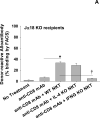Critical role of NKT cells in posttransplant alloantibody production
- PMID: 25220596
- PMCID: PMC4207222
- DOI: 10.1111/ajt.12922
Critical role of NKT cells in posttransplant alloantibody production
Abstract
We previously reported that posttransplant alloantibody production in CD8-deficient hosts is IL-4+ CD4+ T cell-dependent and IgG1 isotype-dominant. The current studies investigated the hypothesis that IL-4-producing natural killer T cells (NKT cells) contribute to maximal alloantibody production. To investigate this, alloantibody levels were examined in CD8-deficient WT, CD1d KO and Jα18 KO transplant recipients. We found that the magnitude of IgG1 alloantibody production was critically dependent on the presence of type I NKT cells, which are activated by day 1 posttransplant. Unexpectedly, type I NKT cell contribution to enhanced IgG1 alloantibody levels was interferon-γ-dependent and IL-4-independent. Cognate interactions between type I NKT and B cells alone do not stimulate alloantibody production. Instead, NKT cells appear to enhance maturation of IL-4+ CD4+ T cells. To our knowledge, this is the first report to substantiate a critical role for type I NKT cells in enhancing in vivo antibody production in response to endogenous antigenic stimuli.
© Copyright 2014 The American Society of Transplantation and the American Society of Transplant Surgeons.
Figures








Similar articles
-
CD8+ T cells negatively regulate IL-4-dependent, IgG1-dominant posttransplant alloantibody production.J Immunol. 2010 Dec 15;185(12):7285-92. doi: 10.4049/jimmunol.1001655. Epub 2010 Nov 17. J Immunol. 2010. PMID: 21084663 Free PMC article.
-
Alloprimed CD8(+) T cells regulate alloantibody and eliminate alloprimed B cells through perforin- and FasL-dependent mechanisms.Am J Transplant. 2014 Feb;14(2):295-304. doi: 10.1111/ajt.12565. Am J Transplant. 2014. PMID: 24472191 Free PMC article.
-
Defining a novel subset of CD1d-dependent type II natural killer T cells using natural killer cell-associated markers.Scand J Immunol. 2019 Sep;90(3):e12794. doi: 10.1111/sji.12794. Epub 2019 Jun 26. Scand J Immunol. 2019. PMID: 31141185 Free PMC article.
-
Dendritic cell maturation overrules H-2D-mediated natural killer T (NKT) cell inhibition: critical role for B7 in CD1d-dependent NKT cell interferon gamma production.J Exp Med. 2001 Oct 15;194(8):1179-86. doi: 10.1084/jem.194.8.1179. J Exp Med. 2001. PMID: 11602646 Free PMC article.
-
Innate Valpha14(+) natural killer T cells mature dendritic cells, leading to strong adaptive immunity.Immunol Rev. 2007 Dec;220:183-98. doi: 10.1111/j.1600-065X.2007.00561.x. Immunol Rev. 2007. PMID: 17979847 Review.
Cited by
-
Invariant NKT Cells Promote the Development of Highly Cytotoxic Multipotent CXCR3+CCR4+CD8+ T Cells That Mediate Rapid Hepatocyte Allograft Rejection.J Immunol. 2021 Dec 15;207(12):3107-3121. doi: 10.4049/jimmunol.2100334. Epub 2021 Nov 22. J Immunol. 2021. PMID: 34810223 Free PMC article.
-
Critical Role of Macrophage FcγR Signaling and Reactive Oxygen Species in Alloantibody-Mediated Hepatocyte Rejection.J Immunol. 2018 Dec 15;201(12):3731-3740. doi: 10.4049/jimmunol.1800333. Epub 2018 Nov 5. J Immunol. 2018. PMID: 30397035 Free PMC article.
-
Re-programming mouse liver-resident invariant natural killer T cells for suppressing hepatic and diabetogenic autoimmunity.Nat Commun. 2022 Jun 7;13(1):3279. doi: 10.1038/s41467-022-30759-w. Nat Commun. 2022. PMID: 35672409 Free PMC article.
-
Activation and Regulation of B Cell Responses by Invariant Natural Killer T Cells.Front Immunol. 2018 Jun 18;9:1360. doi: 10.3389/fimmu.2018.01360. eCollection 2018. Front Immunol. 2018. PMID: 29967611 Free PMC article. Review.
-
Unique CD8+ T Cell-Mediated Immune Responses Primed in the Liver.Transplantation. 2016 Sep;100(9):1907-15. doi: 10.1097/TP.0000000000001290. Transplantation. 2016. PMID: 27379551 Free PMC article.
References
-
- McKenna RM, Takemoto SK, Terasaki PI. Anti-HLA antibodies after solid organ transplantation. Transplantation. 2000;69(3):319–326. - PubMed
-
- Lorenz M, Regele H, Schillinger M, Exner M, Rasoul-Rockenschaub S, Wahrmann M, et al. Risk factors for capillary C4d deposition in kidney allografts: evaluation of a large study cohort. Transplantation. 2004;78(3):447–452. - PubMed
Publication types
MeSH terms
Substances
Grants and funding
LinkOut - more resources
Full Text Sources
Other Literature Sources
Research Materials

